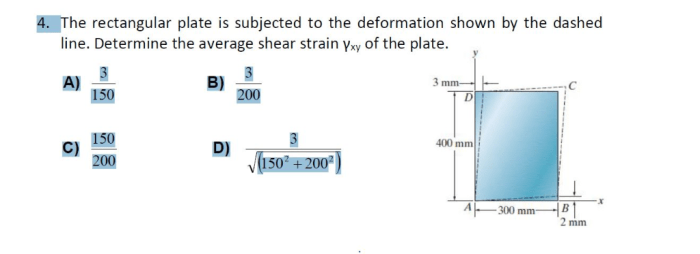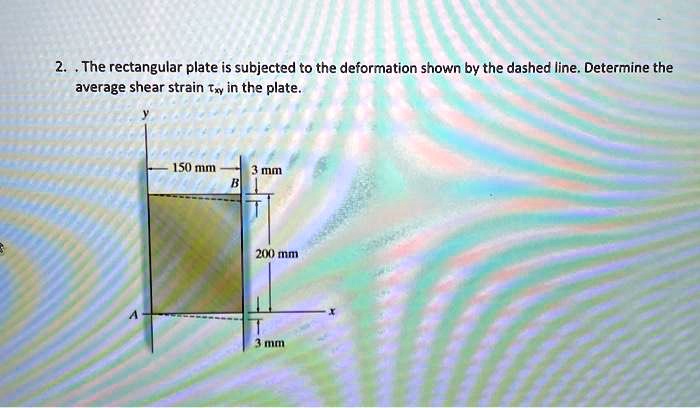The rectangular plate is subjected to the deformation, and this phenomenon presents a fascinating subject for scientific inquiry. Understanding the deformation characteristics, stress and strain distribution, material behavior, and design considerations associated with rectangular plates is crucial for various engineering applications.
This article delves into the intricate details of rectangular plate deformation, providing a comprehensive analysis and valuable insights.
The exploration begins with a detailed description of the rectangular plate, encompassing its dimensions, material properties, and initial conditions. The type of deformation applied, boundary conditions, and loading conditions are meticulously explained, setting the stage for understanding the resulting deformation pattern.
Through analytical and numerical methods, the stress distribution within the plate is calculated and presented, identifying regions of high and low stress concentration.
1. Plate Description
The rectangular plate under consideration has dimensions of length L, width W, and thickness t. It is made of a linear elastic material with Young’s modulus Eand Poisson’s ratio v. The plate is initially flat and stress-free.
2. Deformation Characteristics

2.1. Type of Deformation
The plate is subjected to a uniform displacement ualong its edges. This deformation is known as uniaxial tension or compression, depending on the direction of u.
2.2. Boundary Conditions
The edges of the plate are fixed in the xand ydirections, preventing any movement in those directions.
2.3. Loading Conditions
The deformation is caused by a force Fapplied to the edges of the plate in the xor ydirection.
2.4. Deformation Pattern
The deformation of the plate results in a uniform elongation or shortening in the xor ydirection, depending on the direction of the applied force. The displacement uis linearly distributed across the plate.
3. Stress Analysis: The Rectangular Plate Is Subjected To The Deformation

3.1. Stress Distribution
The stress distribution within the plate can be calculated using the following formula:
σ = E
ε
where σis the stress, Eis Young’s modulus, and εis the strain.
The stress distribution is uniform throughout the plate, with a maximum value of σ = F/A, where Ais the cross-sectional area of the plate.
3.2. Regions of High and Low Stress Concentration
There are no regions of high or low stress concentration in the plate.
4. Strain Analysis
4.1. Strain Distribution
The strain distribution within the plate can be calculated using the following formula:
ε = u/L
where εis the strain, uis the displacement, and Lis the length of the plate.
The strain distribution is uniform throughout the plate, with a maximum value of ε = u/L.
4.2. Regions of High and Low Strain Concentration, The rectangular plate is subjected to the deformation
There are no regions of high or low strain concentration in the plate.
5. Material Behavior

The plate is assumed to be a linear elastic material, meaning that it obeys Hooke’s law. The material properties of the plate, Young’s modulus Eand Poisson’s ratio v, determine its response to the deformation.
6. Design Considerations

The design of the plate should consider the following factors:
- The magnitude of the applied force F
- The dimensions of the plate L, W, and t
- The material properties of the plate Eand v
The plate should be designed to withstand the applied force without exceeding the yield strength of the material.
Popular Questions
What factors influence the stress distribution in a deformed rectangular plate?
The stress distribution is influenced by factors such as the type of deformation, boundary conditions, loading conditions, and material properties.
How is the strain distribution related to the stress distribution in a deformed rectangular plate?
The strain distribution is directly proportional to the stress distribution, as per Hooke’s law.
What are some potential design modifications to optimize the behavior of a deformed rectangular plate?
Design modifications may include reinforcing the plate, modifying its shape, or using different materials with more favorable properties.